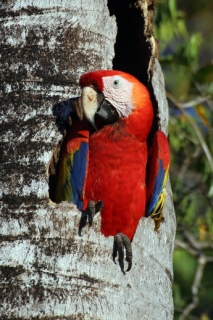Project Regions:
Scarlet Macaw |
|
|
Collaborators/Funders
Paradise Park, Asociación Copán, Macaw Mountain Bird Park and Nature Reserve (PRO-ALAS), HARI (Hagen Avicultural Research Institute), HUGO BOSS/BOSS Orange, In Defense of Animals (IDA), Salvanatura Fundación Ecológica, Program for Belize, American Bird Conservancy (ABC), Kyle Brown Legacy, Barbara Delano Foundation, Keefe Family Foundation, UNAM (National Autonomous University of Mexico), Xcaret Eco-Archeological Park, Birdland UK, Dudley Zoo, and past support for the Macaw Recovery Network.
Macaws are at serious risk throughout their native range
Scarlet Macaws (Ara macao) are threatened by illegal harvesting for the wild bird trade, hunting and habitat loss.
Progress and outcomes: From the mid-1990s WPT has supported direct conservation, education programmes, captive breeding and release, and rehabilitation and release of birds caught in the trade with partners in Mexico and Honduras. PRO-ALAS (Macaw Mountain Bird Park and Nature Reserve) in Honduras has conducted many releases in the Copán valley and into an 870 square kilometre protected zone designated "The Sacred Valley of the Scarlet Macaw." Another group was rewilded to a private island off the coast of Honduras to add to a population there and are now breeding. "Patrulla Con Alas” (Winged Agents), is a project involving children from local communities acting as guardians and birding guides for Scarlet Macaws and other wildlife. The initiative is helping to develop sustainable alternative livelihoods. In Mexico, a multi-year project to restore macaws to Los Tuxtlas Reserve with birds from Xcaret Eco-Archeological Park's breeding centre has seen over 160 Scarlet Macaws released there. For a number of years, the WPT has supported the Macaw Recovery Network in Costa Rica in their efforts to grow and protect macaw populations, spread awareness of ongoing threats and protect habitat.
With your help, we can continue to support actions to conserve this species.
Wild population: 20,000 – 50,000; total C American population no more than 4000.
Where found: A. m. macao: Costa Rica on Pacific slope; S Panama, on Azuero Peninsula and Isla Coiba, then scattered through N South America, east of Andes, from Rio Magdalena valley, Colombia to Guianas and south to E Ecuador, E Peru, E Bolivia and N Mato Grosso, Brazil.
A.m. cyanoptera: Oaxaca and S Tamaulipas, SE Mexico, scattered to NE Nicaragua.
History: The Scarlet Macaw (Ara macao) is found in Mexico, Honduras, Costa Rica, Colombia and Venezuela. Although the Scarlet Macaw is listed by IUCN as Least Concern there is evidence of a population decline in the wild. It is listed by CITES as Appendix I. The declines in this species' population are due to habitat loss and fragmentation (expected to lose 20-35% of habitat within its range over 40 years (Soares-Filho et al. 2006, Bird et al. 2011)), the wild bird trade and hunting for feathers and food.
Threats:
- Habitat loss and fragmentation
- Trapping for the wild bird trade
- Hunting for feathers and food
Ecology: The Scarlet Macaw is found in lowland rainforest and savanna, in Mexico remote portions of humid forest, on the Pacific slope in Honduras, in Costa Rica deciduous and humid forest, Colombia in lowland rainforest and gallery forest and Venezuela in rainforest and savanna. Birds are encountered in pairs, parties of 3-4 or flocks up to 30 individuals as they forage on fruits, fruits and nuts of various palms, and seeds, flowers and nectar.
Project Updates
- PsittaScene Vol. 28.1, Spring 2016
- PsittaScene Vol. 27.4, Winter 2015
- PsittaScene Vol. 25.2, May 2013
- PsittaScene Vol. 24.1, Feb. 2012
- PsittaScene Vol. 23.2, May 2011
- PsittaScene Vol. 23.1, Feb. 2011
- PsittaScene Vol. 21.3, Aug. 2009
- PsittaScene Vol. 17.3, Aug. 2005
- PsittaScene Vol. 15.3, Aug. 2003
- PsittaScene Vol. 12.2, May 2000
- PsittaScene Vol. 11.3, Aug. 1999
- PsittaScene Vol. 5.4, Nov. 1993
Other publications:


































